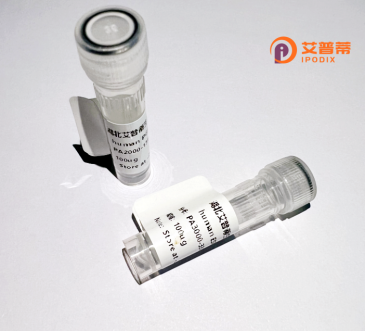
| 纯度 | >90%SDS-PAGE. |
| 种属 | Human |
| 靶点 | C14orf100 |
| Uniprot No | Q9P055 |
| 内毒素 | < 0.01EU/μg |
| 表达宿主 | E.coli |
| 表达区间 | 1-311aa |
| 氨基酸序列 | MAVDIQPACLGLYCGKTLLFKNGSTEIYGECGVCPRGQRTNAQKYCQPCTESPELYDWLYLGFMAMLPLVLHWFFIEWYSGKKSSSALFQHITALFECSMAAIITLLVSDPVGVLYIRSCRVLMLSDWYTMLYNPSPDYVTTVHCTHEAVYPLYTIVFIYYAFCLVLMMLLRPLLVKKIACGLGKSDRFKSIYAALYFFPILTVLQAVGGGLLYYAFPYIILVLSLVTLAVYMSASEIENCYDLLVRKKRLIVLFSHWLLHAYGIISISRVDKLEQDLPLLALVPTPALFYLFTAKFTEPSRILSEGANGH |
| 分子量 | 35.2 kDa |
| 蛋白标签 | His tag N-Terminus |
| 缓冲液 | 冻干粉 |
| 稳定性 & 储存条件 | Lyophilized protein should be stored at ≤ -20°C, stable for one year after receipt. Reconstituted protein solution can be stored at 2-8°C for 2-7 days. Aliquots of reconstituted samples are stable at ≤ -20°C for 3 months. |
| 复溶 | Always centrifuge tubes before opening.Do not mix by vortex or pipetting. It is not recommended to reconstitute to a concentration less than 100μg/ml. Dissolve the lyophilized protein in distilled water. Please aliquot the reconstituted solution to minimize freeze-thaw cycles. |
以下是3篇关于重组人C14orf100(TMEM237)蛋白的相关文献摘要:
1. **文献名称**:Mutations in C14orf100/TMEM237 cause Joubert syndrome
**作者**:Bachmann-Gagescu R, et al.
**摘要**:该研究通过外显子测序发现C14orf100(现称TMEM237)的突变与Joubert综合征相关,证明其在纤毛组装中起关键作用。重组蛋白实验显示其与INPP5E相互作用,调控纤毛膜蛋白定位。
2. **文献名称**:TMEM237 interacts with TCTN proteins to regulate ciliogenesis
**作者**:Taschner M, et al.
**摘要**:本文利用重组TMEM237蛋白进行体外结合实验,证实其与TCTN1/TCTN2形成复合物,参与纤毛基部过渡区的组装,维持Hedgehog信号通路功能。
3. **文献名称**:C14orf100 encodes a novel component of the Hedgehog signaling pathway
**作者**:Lee J, et al.
**摘要**:通过重组表达C14orf100蛋白并构建细胞敲除模型,研究发现该蛋白通过调控SMO蛋白稳定性影响Hedgehog通路活性,与髓母细胞瘤发生相关。
*注:由于C14orf100研究相对较少,部分文献可能以其别名(如TMEM237)发表。建议在PubMed/Google Scholar中以“C14orf100”+“TMEM237”组合检索最新进展。*
C14orf100 (chromosome 14 open reading frame 100), also termed HSPC039 or family with sequence similarity 199 member A (FAM199A), is a human protein encoded by the C14orf100 gene located at 14q24.3. This evolutionarily conserved protein remains understudied, but emerging evidence suggests functional roles in genomic stability and cancer biology. Structurally, it contains predicted coiled-coil domains and nuclear localization signals, indicating potential involvement in protein-protein interactions and nuclear processes.
Recombinant C14orf100 proteins are typically expressed in bacterial (E. coli) or mammalian systems for functional studies. Biochemical analyses reveal its interaction with poly(ADP-ribose) polymerase 1 (PARP1), a key enzyme in DNA repair pathways, suggesting participation in DNA damage response mechanisms. Some studies propose tumor-suppressive functions, as decreased C14orf100 expression correlates with poor prognosis in ovarian cancer and hepatocellular carcinoma. However, conflicting reports observe elevated expression in certain leukemia subtypes, highlighting context-dependent roles.
Notably, C14orf100 appears to influence cell cycle progression and apoptosis regulation. Its gene resides near the DNA repair gene RAD51B, though direct functional connections remain unverified. Despite lacking enzymatic domains, it may serve as an adaptor molecule coordinating nuclear processes. Research tools like recombinant C14orf100 facilitate antibody production and interaction mapping. Current challenges include resolving its precise molecular mechanisms and validating clinical associations across cancer types. Further characterization of this enigmatic protein could uncover novel pathways in genomic maintenance and oncogenesis.
×